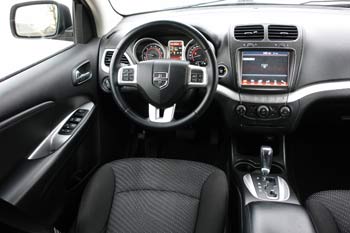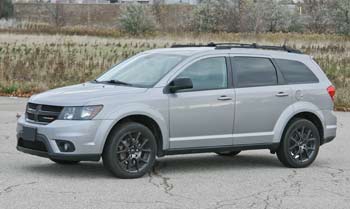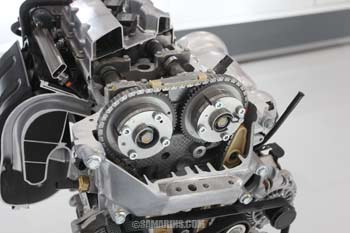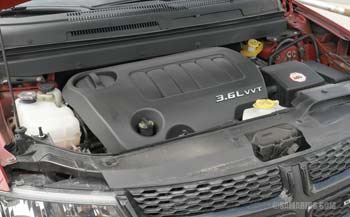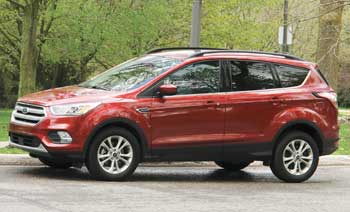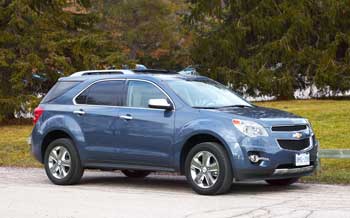2009-2020 Dodge Journey: pros and cons, common problems
By Vlad Samarin Updated: March 20, 2023
The Dodge Journey is a stylish 5- or 7-seater crossover. It offers a roomy interior and pleasant driving experience. In the U.S. and Canada, the Journey is available with a 4-cylinder or V6 engine, with front- or all-wheel drive. For 2011, the Journey received a Pentastar 3.6L V6, Uconnect system and a few other updates. The Journey has been discontinued after 2020.
Compared to many other similar vehicles, a used Dodge Journey is not very expensive, but what are the pros and cons and common problems?
Pros:
- Stylish look.
- Roomy practical nicely done interior (2011+).
- Good handling, comfortable ride.
- Storage and cargo space.
- Available third-row seating.
- Strong optional V6.
- Doesn't hold its value well.
- Electrical, wiring problems, higher than average repair costs.
- Interior plastic could be better.
- Lack of cargo space behind the third seat.
Starting issues: Many owners of the 2009 and 2010 Journey mentioned that the engine wouldn't start at random; all you get is a click, as if the battery is dead. Of course, the battery must be checked first, as an old and weak battery can cause many electrical gremlins. Some owners said that the trick that worked for them was to try starting it in Neutral (with brakes applied) and if it starts, then the problem is related to the transmission range (PRNDL) switch or the shifter cable. Read more: 2 Reasons Why a Car Won't Start in Park but Starts in Neutral
Some owners said that the starter motor had to be replaced. There are a couple YouTube videos where owners report that reinforcing the engine ground cable fixed the problem.
According to the owner's manual, if the fob battery is weak and the system does not recognize the key, the car can be started by placing the fob against the Stop/Start button and pushing it to operate the ignition. Read also: What can cause a car not to start?
Fiat Chrysler (FCA) issued several recalls, including recall R03 / NHTSA 14V-373 for the wireless ignition node (WIN) module and the keys (FOBIKs) that can cause the engine to shut down. Dodge also issued Safety Recall R61 for the Anti-Lock Brake System (ABS) control module. There were few other recalls and numerous software updates. Check for recalls at the NHTSA website.
Various other electrical issues have been reported, including with the radio, horn, power windows and locks, battery draining, rear view camera and Bluetooth; mostly in earlier model years. Several owners mentioned at the NHTSA website that the wires in the driver's door harness and the liftgate harness can break and cause many electrical issues.
In the 2009 and 2010 Journey, faulty rocker arms (Rocker Arm Assembly) in a 3.5L SOHC V6 can cause a tapping, knocking or ticking noise coming from under the valve cover. Replacing a rocker arm assembly in a repair shop can cost up to $1,000. Of course, this type of noise can be caused by other problems and must be properly diagnosed first.
Throttle body: Throttle body can fail and may need to be replaced in the 2.4L engine. One of the symptoms of a failing throttle body is an unusual clicking noise from under the hood when turning the ignition on. A failing throttle body can cause the code P2110, P2111 and P2112.
3.6L V6 ticking noise:A similar problem with the 3.6L Pentastar V6 in the 2011-plus Journey is mentioned on various forums: A ticking noise coming from under the valve covers (top of the engine) might be caused by a worn out rocker arm(s). We found several YouTube videos and this article explaining the issue.
As long as the camshaft is not damaged, the repair is not too extensive. However, if the vehicle is continued to be driven with bad rocker arms, the camshaft(s) might get damaged too. This will require a more expensive repair. This means that if you hear a ticking noise coming from the top of the engine, have it checked out. Your mechanic may suggest replacing all rocker arms as a precaution even if only one or two are bad.
Left cylinder head: In the early 3.6L Pentastar V6, there have been problems with the left cylinder head causing the engine to misfire (trouble codes P0300, P0302, P0304 and P0306). FCA has extended the warranty on the 3.6L Left Cylinder Head in some 2011-2013 Dodge Journey (X56 Warranty Extension). The warranty extension coverage period is 10 years / 150,000 miles (240,000 km) (whichever occurs first) from the vehicles in-service date. It's not a recall and only applies if the vehicle has this particular defect. The repair involves replacing the left (front) cylinder head with related parts. If out of warranty, the repair will be expensive.
Oil filter housing: An oil filter housing in the Pentastar 3.6L V6 engine might need to be replaced if it leaks oil or if the oil by-pass valve is broken in the 2011-2013 Journey. Here is a good video explaining issues with this part.
The FCA bulletin 18-034-14 for the 2013-2014 Journey ( JC) mentions the problem with an oil pressure sensor (sending unit) that can cause the Check Engine light with the trouble code P0520. To repair the problem, the oil pressure sensor needs to be replaced. If out of warranty, the part is sold for around $30-$60 online, plus the labor.
Blend door actuator: A failed blend door actuator for the HVAC system can cause the A/C or heater to work only on one side. It can also cause a clicking noise under the dash.
Advertisement
Several owners reported various axle seals in the transmission and rear differential (in AWD), as well as seals in the transfer case (PTU) leaking. If you notice oil drops on the parking spot or burnt oil smell from under the car, have it checked out, as lack of fluid/oil can cause the component to fail.
According to the service bulletin 02-001-13, the noise from the front of the vehicle when going over bumps or turning can be caused by bad front strut mounts/bearings. Replacing one strut mount in the shop should cost $150-$240 per side.
Premature brake wear was one of the top complaints in earlier model years at CarComplaints.com. Servicing brakes at least once a year may prevent brake calipers from seizing and overheating.
A bad wheel bearing can cause a humming or rumbling noise that gets louder with speed and in turns. Replacing a wheel bearing will cost from $220 to $460 for one.
FCA has issued several updates for the Uconnect software to fix various glitches. Visit DriveUconnect.com to check for updates. We also found reports that hard-resetting the system by disconnecting the battery fixes some of the glitches.
Coolant leaks from the Y-split portion of the heater hose assembly, cracked coolant reservoir and other sources have also been reported. Replacing a heater hose assembly can cost up to $700. A lack of coolant can cause the engine to overheat, so it's important to get the cooling system leak diagnosed and repaired as soon as possible.
Other reported problems include bad TPMS sensors, bad key fobs, various electrical, wiring issues and harsh shifting, shuddering or failures of the transmission.
Summary: The Dodge Journey's reliability is not great. As of 2020, JD Power rated a used Dodge Journey for quality and reliability lower than many similar vehicles. If you check owner reviews online they are mixed: many owners compliment driving experience and the interior, but mention various problems and high cost of repairs. The Journey also tends to depreciate a lot with age.
On the plus side, it's a good looking vehicle and it does have a stylish, practical and roomy interior. The Uconnect with a 8.4-inch screen is one of the best systems on the market in terms of design and features. The Journey is easy to drive and handles well for a crossover. The 3.6L V6 is smooth and has plenty of power. The 2.4L inline-4 is mostly trouble-free. On the used car market, a Dodge Journey is much cheaper than a comparable Toyota Highlander, which is one of the top choices in this segment.
If you are buying a used Dodge Journey it's not the vehicle to pay top dollars for. Consider a good extended warranty that can help with repair costs.
Related Reviews:
Honda Odyssey 2011-2017
Honda Pilot 2009-2015
Mazda CX-9 2007-2015
Toyota Venza 2009-2015
Nissan Pathfinder 2013-2019
What to look for when buying a used Dodge Journey: If you want to buy a used Dodge Journey, check the history records to see if the car was used as a rental vehicle. Check if all recalls have been done. If it's a 3.5L V6 in the 2009, 2010 Journey, check if the timing belt has been replaced.
Because some 2011-2013 Journeys with a 3.6L V6 may had an issue with the cylinder head that is not obvious during a test drive, we would recommend to have the vehicle checked by a mechanic familiar with Chrysler products and even scan the engine computer for pending fault codes and check for leaks underneath.
When checking the car, check for signs of water leaking from the sunroof area. See if the headrests and seats are comfortable for you. Test all the electronic features, such as the touchscreen, windows, locks, both key fobs and the air conditioner carefully, take your time.
If you use Bluetooth, check if you can pair your phone; it's one of the common concerns. Check if the rear-view camera works; it also received many complaints. During a test drive, watch out for the way the transmission shifts. Particularly watch out for slipping, shudder, rough shifting or jolts when shifting or a whining noise. The transmission should shift smoothly.
Watch out for a ticking noise from the engine. During the test drive, watch out for the engine temperature gauge showing signs of overheating. Overheating can cause many problems. Often, overheating is caused by a lack of coolant. One of the symptoms of coolant leaks is low coolant level in the coolant expansion tank and a coolant smell under the hood.
Avoid the vehicle if the Check Engine light is staying on or if the engine runs noisy or if there is a smoke from exhaust or if there are signs of electrical or transmission problems. Read more: How to inspect a used car?
Engines: The base engine is a 173-hp 2.4L DOHC inline-4 known as World Gas Engine. For 2020, it's the only engine choice. It's a bit underpowered for a vehicle of this size, but otherwise solid. There are not that many reported problems related to this engine.
The optional V6 in the 2009 and 2010 Journey is a 235-hp 24-valve 3.5L SOHC V6 that Chrysler has used in many vehicles for years. With good care, this engine can last long. Here is an interesting post at Dodgejourneyforum.com
For the 2011, the Journey received a new 3.6L Pentastar V6 that was available until 2019. It's a modern high-tech DOHC engine with an advanced design. It offers 283 horsepower and 260 lb-ft of torque. Watch the video of Pentastar engine manufacturing at Mack Avenue Engine Plant in Detroit. The Pentastar V6 was named one of Ward's 10 Best Engines, but it wasn't completely trouble-free, especially in early models.
Fuel Economy: The EPA rates the front-wheel drive Dodge Journey with a 2.4L 4 cylinder engine at 19/26 mpg for 2011-2013 models and at 19/25 mpg city/highway for all other model years up to 2019.
The 2011-2019 all-wheel drive Journey with a 3.6L V6 is rated at 16/24 mpg with an estimated range of 464 miles (747 km) on one tank of gas on a long trip.
Timing belt or Timing chain: The 3.5L SOHC V6 engine has a timing belt. According to the 2009 Dodge Journey owner's manual, it must be replaced every 102,000 miles or every 102 months (8.5 years), whichever occurs first. The 2.4L World Gas Engine and the 3.6L Pentastar V6 have a timing chain. The timing chain doesn't need to be replaced unless there is a problem with it.
